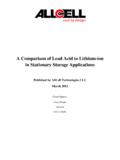Transcription of The Regulatory Maze of Lithium Battery Safety - …
1 navigating the Regulatory Maze of Lithium Battery Safety Tom O'Hara Global Business Manager / Advisory Services 1. Introduction Governments regulate those areas in life where significant hazards are presented. One example is automotive regulations, which cover issues ranging from gas tank Safety to crash protection to lighting strike. Regulations reach beyond the manufacturing of the vehicle to encompass usage of the vehicle and require that drivers are licensed and have auto insurance. Government regulation to protect individuals from the hazards associated with Lithium batteries is no different.
2 When a risk of significant personal hazard is exposed, a regulation will likely follow. This paper provides a high level, view of global Lithium Battery Safety standards and regulations. Standards, Organizations, and Regulations To someone new to Battery testing and certification, the number of Lithium Battery standards, governing organizations, and regulations can be overwhelming. One problem is that these various standards and organizations sound all too similar: UL 1642; IEEE 1625; IEEE 1725;. ISO/IEC 17025. Industry veterans further complicate understanding by simply referring to the standards' numbers: 1642; 1625; 1725; 17025.
3 And sometimes, people truncate even further (IEC 60086 becomes 086). Plus, in addition to Battery standards, there are technical committees (such as TC108) and sub-committees (such as SC 21A). And, of course, the organizations themselves: IEEE; IEC; IECEE. Sound confusing? Take a look below: There are entities and their European counterparts. Japan has their own standards, as do other parts of the world. Equipment manufacturers often have additional internal standards and specifications which they apply in order to better protect both their brand and consumers.
4 Some regulations are statutory requirements, while others are guidelines, and some are not mandatory at all but are essentially required if company wants to sell their product to a retailer or device manufacturer who requires all device components to be Safety listed. Still confused? Fundamentally, the Battery Safety industry, which initially appears to be extremely complex, is actually fairly straightforward. Developing an understanding of just a small handful of organizations and Battery standards will suffice to address well over 90% of your potential confusion.
5 This paper takes a simple, first step towards understanding Lithium Battery certification and regulation and is not intended to be an exhaustive, complete listing of all standards covering Lithium batteries. 2. Based Organizations & Standards OSHA (Occupational Safety and Health Administration). In the , workplace and product Safety essentially begins with OSHA, an agency of the United States Department of Labor. Its mission is to prevent work-related injuries, illnesses, and occupational fatality by issuing and enforcing standards for workplace Safety and health.
6 For the purposes of this paper, OSHA's role is to approve and maintain a list of NRTLs. What is an NRTL? Under the narrow scope of this paper, a Nationally Recognized Testing Laboratory is a testing facility recognized by OSHA as having the resources and competence to provide product Safety testing and certification for Lithium batteries and cells. The test standards which NRTLs follow are not developed or issued by OSHA, but are issued by standards organizations -- such as ANSI (the American National Standards Institute) or UL (Underwriter's Laboratories) both of which produce consensus-based product Safety test standards.
7 Intertek is one of over a dozen NRTLs. Certification Marks Issued by an NRTL. Each NRTL has their own registered certification mark. Because all NRTLs are equivalent under OSHA, all NRTL marks carry the same authority and Regulatory significance: they indicate that the certified product complies with specific Safety requirements of the subject standard. For example, when Intertek certifies a Battery to UL 2054, they issue their own NRTL. mark, the ETL Mark, to certify that the Battery complies to the Safety requirements contained in UL 2054.
8 In this case, the product will be UL 2054 certified but it will not have the UL Mark. Instead, it will be labeled with Intertek's mark, the ETL Mark. NOTE: Most NRTLs including Intertek will accept another NRTL's test results, but some will not. For example, when testing a Battery to UL 2054, most NRTLs will accept another NRTL's cell level UL 1642 test data and apply it to their UL 2054 testing. This saves the client time and money. When a NRTL does not accept test data from another and requires all testing to be performed by themselves, the client incurs the redundant costs of duplicate testing plus program delays.
9 CE Marking The European Union's CE Marking requirements help to ensure that all Safety requirements are met. CE Marking is a self declaration made by the manufacturer to acknowledge that a product meets requirements for EU product Safety . The CE Mark does not apply to products sold in the The American National Standards Institute (ANSI). ANSI is a private non-profit organization which develops consensus-based standards. ANSI. standards are published by NEMA (National Electrical Manufacturers Association). ANSI's C18. 3. is a comprehensive Battery standard covering general information, Battery specifications and Safety standards for consumer batteries of all types (standard alkaline AA, 3A, C, D, etc; Lithium coin cells; rechargeable NiMH; etc.)
10 ANSI's Safety standards for primary and rechargeable Lithium and Lithium -ion cells and batteries are listed here: ANSI , Part 2. (Portable Rechargeable Cells and Batteries - Safety Standard). ANSI , Part 2. (Portable Lithium Primary Cells and Batteries - Safety Standard). NOTE: In its attempt to harmonize C18 test details with competing standards, ANSI takes care to review all relevant global standards during the writing process. In this effort of standards harmonization, ANSI is not alone. ANSI's UL and IEC counterparts also look to harmonize across standards.


